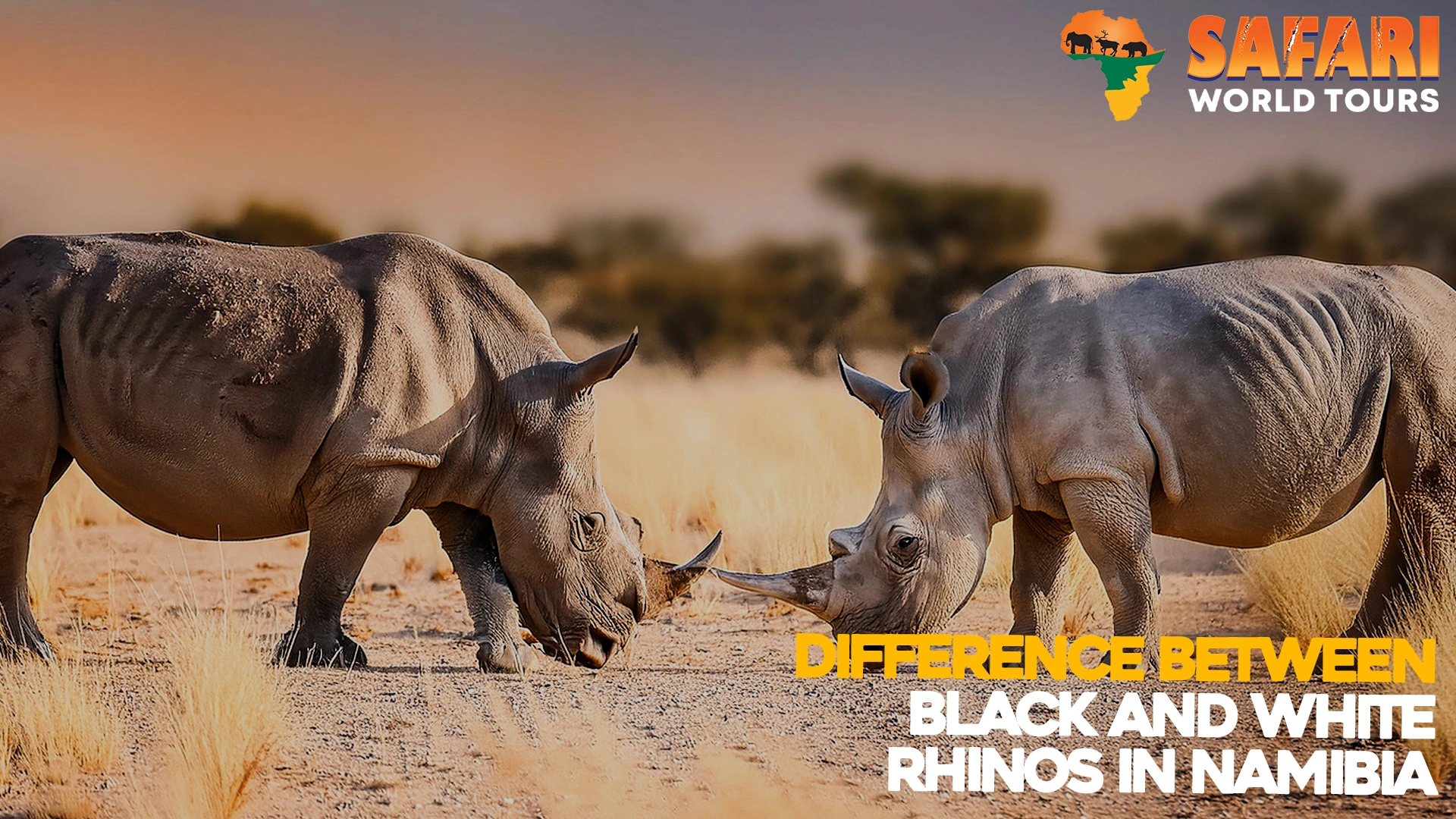The rhino is a huge mammal with a nasal horn, and the white rhino can weigh as much as 2,300kg, while the black rhino can as well weigh about 1,400kg. The rhino is one of the largest land mammals in the world, only second behind the elephant Black and White Rhino.
The question a lot of people ask is, “Are the Rhinos black or white?” In reality, the rhino is never black or white; instead, it has a color between brown and gray.
The animal derives its name from a rather funny way- in the Afrikaans language, the word “Weit” means “Wide” in the English language and was used to describe the rhino’s mouth was mistakenly taken to mean “white.” Therefore, the animal became known as the “white rhino.” Black and White Rhino
However, in black and white, the Rhino are differentiated by the shape of their lip- the former is said to have a narrower and pointed lip, while the latter is said to have a wide and square upper lip.
They both have different scientific names, the black rhino, known as “Diceros bicornis,” and the white simple, known as “Ceratotherium simum.” They are known to have a life span of about 35 to 40 years.
Africa has about 98% rhino concentration, and it is distributed among three countries, namely, Namibia, Kenya, Zimbabwe, and South Africa is said to have about 40% of the total population of black Rhinos.
THE BLACK RHINO
The black rhino’s mouth is shaped differently from the white rhino, having a pointed upper lip. There used to be a widespread of rhinos around the world, but there has been a major decline causing the population of black rhinos to decrease by 96% between 1970 and 1992 (Black and White Rhino).
By the end of 1992, the population of black rhinos dropped from about 65000 to just about 2,300 surviving. This is largely due to poaching, but g reat efforts have been put into their conservation by many bodies. A higher level of recovery has been witnessed since the anti-poaching campaign, yet the animal is still said to be critically endangered. Research shows that the black rhino can live as much as 40 to 50 years (Black and White Rhino).
reat efforts have been put into their conservation by many bodies. A higher level of recovery has been witnessed since the anti-poaching campaign, yet the animal is still said to be critically endangered. Research shows that the black rhino can live as much as 40 to 50 years (Black and White Rhino).
THE WHITE RHINO

The white rhino is known to have a wide mouth and a square-shaped lip; the male weighs about 2,300kg, while the female weighs about 1,700kg. The males usually have higher weight compared to the females, the former weighing about 3.6 tons and the latter weighing about 1.7 tons.
The world’s oldest white rhino, Sudan, was the last male northern rhino. It died at the Ol Pejeta Conservancy; Kenya’s wildlife preserve park, in March 2018 and was said to have lived a wonderful 45 years
Black and White Rhino The rhinoceros is gradually threatened despite efforts to discourage poaching and illegal trade of the animal from saving the animal from the brink of extinction. The animals are killed, and their horns are collected for medicinal purposes in China, Hong Kong, and Taiwan, while it is used for ornamental dagger handles in North Africa and the Middle East (Black and White Rhino).
The population of rhinoceros has dropped largely due to poaching, as they are killed for their horns.
CONSERVATION STATUS AND THREATS TO BLACK AND WHITE RHINOS IN NAMIBIA
Both black and white rhinos in Namibia are classified as endangered species by the International Union for Conservation of Nature (IUCN). While their populations have seen some growth due to conservation efforts in recent years, both species continue to face significant threats to their survival.
Poaching is the biggest threat to rhinos in Namibia. Rhino horn is highly valued in some cultures for its supposed medicinal properties, even though it is made of keratin, the same material as human hair and nails.
As a result, rhinos are hunted for their horns, which can fetch high prices on the black market. Rhino horn poaching is a serious problem in many parts of Africa, including Namibia (Black Rhino vs White Rhino).
Habitat loss and fragmentation are also major threats to Rhino in Namibia. The country’s human population is growing, and as a result, more land is being converted for agricultural and urban development.
This means that rhinos are losing their natural habitats and are becoming more vulnerable to poaching and other threats (Black Rhino vs White Rhino).

Conservation efforts in Namibia have focused on several key strategies, including anti-poaching patrols, community-based conservation initiatives, and sustainable tourism practices (Black Rhino vs White Rhino).
These efforts have helped to stabilize rhino populations in some areas, but ongoing vigilance and investment are needed to ensure the long-term survival of these magnificent animals in Namibia.
FAQs
Q: What is the difference between a Black Rhino vs White Rhino?
A: Black Rhino vs White Rhino The main physical difference between black and white rhinos is the shape of their mouths. Black rhinos have hooked upper lips, while white rhinos have flat, wide upper lips.
Q: Why are black rhinos called black rhinos if they’re not black?
A: Black rhinos are called black rhinos due to a mistranslation of the Afrikaans word “swart,” which means “wide” and refers to the shape of their mouths. The name has nothing to do with the rhino’s color.
Q: Are black or white rhinos more endangered?
A: Both black and white rhinos are classified as endangered species, but black rhinos are considered to be more endangered due to their smaller populations and higher rates of poaching.
Q: Where can I see black and white rhinos in Namibia?
A: Both black and white rhinos can be found in several national parks and reserves in Namibia, including Etosha National Park and the Waterberg Plateau Park.
Q: What do black and white rhinos eat?
A: Both black and white rhinos are herbivores and primarily eat grasses, but they may also eat leaves, branches, and fruits.
Q: Can I go on a rhino tracking or viewing experience in Namibia?
A: Yes, there are several tour operators and lodges in Namibia that offer rhino tracking and viewing experiences. However, these experiences are often tightly regulated to ensure the safety of both humans and rhinos.
Q: How can I help protect black and white rhinos in Namibia?
A: You can support rhino conservation efforts in Namibia by donating to reputable conservation organizations, spreading awareness about the importance of rhino conservation, and choosing to visit lodges and tour operators that prioritize responsible and sustainable tourism practices.


